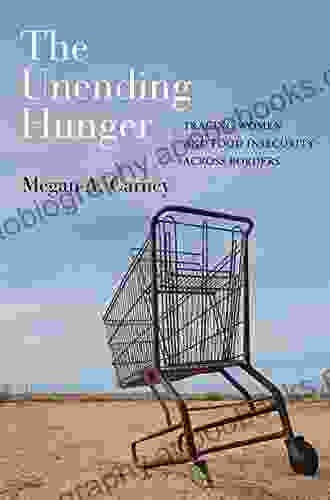Tracing Women And Food Insecurity Across Borders: A Comprehensive Guide

Food insecurity is a global challenge that disproportionately affects women. Around the world, women are more likely than men to experience hunger and malnutrition. This is due to a number of factors, including gender inequality, poverty, and lack of access to education and resources.
4.7 out of 5
| Language | : | English |
| File size | : | 6539 KB |
| Text-to-Speech | : | Enabled |
| Screen Reader | : | Supported |
| Enhanced typesetting | : | Enabled |
| Word Wise | : | Enabled |
| Print length | : | 274 pages |
| Lending | : | Enabled |
The consequences of food insecurity for women are far-reaching. It can lead to health problems, such as malnutrition, anemia, and stunted growth. It can also lead to economic problems, such as reduced productivity and lost income. In some cases, food insecurity can even lead to violence against women.
There are a number of things that can be done to address food insecurity among women. These include:
- Investing in women's education and empowerment
- Reducing gender inequality
- Improving access to food and nutrition
- Providing social protection programs
- Addressing the root causes of food insecurity, such as poverty and conflict
By taking these steps, we can help to create a world where all women have access to the food they need to live healthy and productive lives.
The Causes of Food Insecurity Among Women
There are a number of factors that contribute to food insecurity among women. These include:
- Gender inequality: Women are often discriminated against in terms of access to education, employment, and land ownership. This discrimination can make it difficult for women to earn a living and provide for their families.
- Poverty: Poverty is a major cause of food insecurity. Women are more likely than men to live in poverty, and they are also more likely to be employed in low-paying jobs. This makes it difficult for women to afford food for themselves and their families.
- Lack of access to education and resources: Women often lack access to education and resources, such as healthcare and agricultural training. This can make it difficult for women to learn about nutrition and how to grow their own food.
- Conflict and displacement: Conflict and displacement can disrupt food production and distribution systems. This can make it difficult for women to access food, even if they have the resources to afford it.
The Consequences of Food Insecurity for Women
Food insecurity can have a number of negative consequences for women. These include:
- Health problems: Food insecurity can lead to a number of health problems, such as malnutrition, anemia, and stunted growth. These health problems can make it difficult for women to work and care for their families.
- Economic problems: Food insecurity can lead to economic problems, such as reduced productivity and lost income. This can make it difficult for women to support themselves and their families.
- Violence: In some cases, food insecurity can lead to violence against women. This is because women who are hungry and desperate may be more likely to engage in risky behaviors, such as selling sex or stealing food.
Solutions to Food Insecurity Among Women
There are a number of things that can be done to address food insecurity among women. These include:
- Investing in women's education and empowerment: Investing in women's education and empowerment is one of the most effective ways to reduce food insecurity. Educated women are more likely to be employed, earn higher incomes, and have access to resources such as healthcare and agricultural training.
- Reducing gender inequality: Reducing gender inequality is essential to addressing food insecurity among women. This means ensuring that women have equal access to education, employment, and land ownership.
- Improving access to food and nutrition: Improving access to food and nutrition is essential to addressing food insecurity. This means ensuring that women have access to affordable, nutritious food. It also means providing women with information about nutrition and how to grow their own food.
- Providing social protection programs: Social protection programs can help to reduce food insecurity by providing women with cash or food assistance. These programs can help women to meet their basic needs and avoid hunger.
- Addressing the root causes of food insecurity: Addressing the root causes of food insecurity, such as poverty and conflict, is essential to long-term solutions. This means investing in sustainable agriculture, reducing poverty, and promoting peace.
By taking these steps, we can help to create a world where all women have access to the food they need to live healthy and productive lives.
Food insecurity is a serious problem that affects millions of women around the world. It is caused by a number of factors, including gender inequality, poverty, and lack of access to education and resources. The consequences of food insecurity for women are far-reaching, and they can include health problems, economic problems, and violence. However, there are a number of things that can be done to address food insecurity among women. These include investing in women's education and empowerment, reducing gender inequality, improving access to food and nutrition, providing social protection programs, and addressing the root causes of food insecurity. By taking these steps, we can help to create a world where all women have access to the food they need to live healthy and productive lives.
References
- World Hunger and Poverty Facts and Statistics
- Food Security
- Gender and Food Security
4.7 out of 5
| Language | : | English |
| File size | : | 6539 KB |
| Text-to-Speech | : | Enabled |
| Screen Reader | : | Supported |
| Enhanced typesetting | : | Enabled |
| Word Wise | : | Enabled |
| Print length | : | 274 pages |
| Lending | : | Enabled |
Do you want to contribute by writing guest posts on this blog?
Please contact us and send us a resume of previous articles that you have written.
 Book
Book Novel
Novel Page
Page Chapter
Chapter Text
Text Story
Story Genre
Genre Reader
Reader Library
Library Paperback
Paperback E-book
E-book Magazine
Magazine Newspaper
Newspaper Paragraph
Paragraph Sentence
Sentence Bookmark
Bookmark Shelf
Shelf Glossary
Glossary Bibliography
Bibliography Foreword
Foreword Preface
Preface Synopsis
Synopsis Annotation
Annotation Footnote
Footnote Manuscript
Manuscript Scroll
Scroll Codex
Codex Tome
Tome Bestseller
Bestseller Classics
Classics Library card
Library card Narrative
Narrative Biography
Biography Autobiography
Autobiography Memoir
Memoir Reference
Reference Encyclopedia
Encyclopedia Alan Hlad
Alan Hlad Alan R Karls
Alan R Karls Alberto Carretero
Alberto Carretero Dan Roodt
Dan Roodt Charles Dickens
Charles Dickens Cullen Bunn
Cullen Bunn Penny Ashman
Penny Ashman Sarah Howe
Sarah Howe Oliver Clarke
Oliver Clarke Alan J Kuperman
Alan J Kuperman Benny Christen Grandahl
Benny Christen Grandahl Eliot A Cohen
Eliot A Cohen Assia Djebar
Assia Djebar Greg Palast
Greg Palast Rajesh Thakur
Rajesh Thakur Jake Finch
Jake Finch Joe Sharkey
Joe Sharkey Jen Eskridge
Jen Eskridge Caroline Lee
Caroline Lee Vladimir Yakunin
Vladimir Yakunin
Light bulbAdvertise smarter! Our strategic ad space ensures maximum exposure. Reserve your spot today!

 Craig Blair52 First Dates: Volume Parts: A Heartfelt Exploration of Love, Memory Loss,...
Craig Blair52 First Dates: Volume Parts: A Heartfelt Exploration of Love, Memory Loss,...
 Junot DíazInto The Forest and All the Way Through: Embark on an Unforgettable Literary...
Junot DíazInto The Forest and All the Way Through: Embark on an Unforgettable Literary...
 W. Somerset MaughamColored Man Reminiscences Of James Madison: A Captivating Journey Through...
W. Somerset MaughamColored Man Reminiscences Of James Madison: A Captivating Journey Through... Neil ParkerFollow ·6.7k
Neil ParkerFollow ·6.7k E.M. ForsterFollow ·3.7k
E.M. ForsterFollow ·3.7k Ibrahim BlairFollow ·19.5k
Ibrahim BlairFollow ·19.5k Tony CarterFollow ·15.8k
Tony CarterFollow ·15.8k Jaylen MitchellFollow ·2k
Jaylen MitchellFollow ·2k Ian MitchellFollow ·2.7k
Ian MitchellFollow ·2.7k Dale MitchellFollow ·8.1k
Dale MitchellFollow ·8.1k Cody RussellFollow ·3.9k
Cody RussellFollow ·3.9k

 W. Somerset Maugham
W. Somerset MaughamBach Dialogue With Modernity: A Journey Through Time and...
Prelude: Bach's Timeless...

 Ted Simmons
Ted SimmonsAsher Heroes At Heart Maryann Jordan: The Essential Guide...
Are you ready to...

 Paulo Coelho
Paulo CoelhoVienna Spies: Uncover the Hidden World of Espionage in...
Vienna has long...

 Herman Melville
Herman MelvilleThe Complete Guide to Orchestral Cymbal Playing:...
Step into the vibrant...

 Rubén Darío
Rubén DaríoEscape into a Holiday Haven with California Christmas...
Embark on a heartwarming and festive journey...
4.7 out of 5
| Language | : | English |
| File size | : | 6539 KB |
| Text-to-Speech | : | Enabled |
| Screen Reader | : | Supported |
| Enhanced typesetting | : | Enabled |
| Word Wise | : | Enabled |
| Print length | : | 274 pages |
| Lending | : | Enabled |








